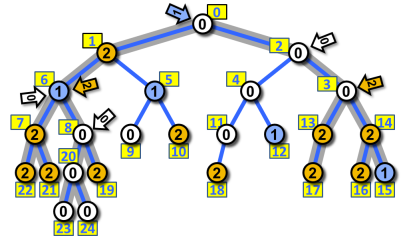Full Paths in Binary Tree
In a binary rooted tree, each node is assigned one of given Q distinct colors.
A so-called regulating value D is positive a integer.
We say that a node x is (c, D)-full, if the subtree which root is x contains exactly
D nodes of color c.
Furhermore, we say that a path from the root to some leaf in the tree is full if it contains at least one
(c, D)-full node for each color c out of given C colors.
 Image 1. An example of a tree in which each node is colored by one of 3 colors: 0 - white, 1 - blue and 2 - orange. Node labels are written close to the node on yellow background. The regulating value D is equal to 4. Nodes 2, 6 and 8 are all (0, 4)-full, nodes 3 and 6 are (2, 4)-full and the node 0 is (1, 4)-full. These noded are marked by an arrow of the corresponding color. There are 8 full paths in the tree, their edges are highlighted in grey. |
Â
The task
You are given a binary tree, the color of each node and a regulating value D. Determine the number of full paths in the tree.
Input
The first input line contains three integers N, C, D separated by spaces and representing the number of nodes in the tree, the number of node colors and the regulating value.
We assume that the nodes are labeled 0, 1, ..., N−1 and the colors are labeled 0, 1, ..., C−1. The label of the tree root is always 0.
The next line contains N integers, separated by spaces, which represent the list of colors of particular nodes. The colors are listed in ascending order of node labes. The first integers represents the color of node 0, the second integer represents the color of node 1, etc.
Next, there are N −1 text lines, each specifies one edge in the tree. The line contains two integers a, b separated by space. Integer a is the label of the parent of the node which label is b.
It holds, 2 ≤ N ≤ 150000, 2 ≤ C ≤ 10, 2 ≤ D ≤ 20.
Output
The output contains one text line with a single integer representing the number of full paths in the input tree.
Example 1
Input25 3 4 0 2 0 0 0 1 1 2 0 0 2 0 1 2 2 1 2 2 2 2 0 2 2 0 0 20 23 7 22 8 20 11 18 13 17 14 16 3 13 4 11 5 9 6 7 1 6 2 4 0 1 0 2 2 3 1 5 6 8 5 10 4 12 3 14 7 21 8 19 14 15 20 24Output
8The tree in Example 1 is depicted in Image 1.
Example 2
Input16 2 3 0 0 1 1 0 0 1 1 0 1 0 1 0 1 1 1 0 1 1 2 2 3 1 4 4 5 4 6 0 7 7 8 8 9 8 10 7 11 11 12 11 13 13 14 13 15Output
5
Example 3
Input6 5 1 0 1 2 3 4 4 3 4 3 5 2 3 1 2 0 1Output
2
Public data
The public data set is intended for easier debugging and approximate program correctness checking. The public data set is stored also in the upload system and each time a student submits a solution it is run on the public dataset and the program output to stdout and stderr is available to him/her.
Link to public data set